Soil is one of the most valuable natural resources on Earth. It gives us food, supports forests, maintains biodiversity, and balances the ecosystem. Unfortunately, soil pollutions are becoming a growing problem due to industrial waste, plastics, pesticides, and chemical fertilizers. If left unchecked, such soil contaminations affect crops, groundwater, and even human health, just as life without electricity would disrupt modern living.
In this article, we’ll explore 10 effective ways to control soil pollution using natural, eco-friendly, and sustainable methods. Along the way, we’ll also highlight causes, effects, preventive measures, and soil conservation practices that can make a real difference.
Proper Waste Disposal Methods
One of the simplest ways to control soil pollution is by managing waste responsibly. Household garbage, industrial waste, and medical waste should never be dumped directly onto land. When waste decomposes improperly, harmful chemicals seep into the ground, leading to soil contamination.
- Separate biodegradable waste for composting.
- Recycle non-biodegradable items like plastics, glass, and metals.
- Dispose of hazardous waste like batteries and e-waste at special collection centers.
Reduce Use of Pesticides and Chemicals
Modern farming heavily depends on chemical fertilizers and pesticides, but their overuse damages the soil’s natural fertility. These chemicals not only pollute the soil but also enter the food chain.
Instead, farmers and gardeners should adopt:
- Organic farming techniques.
- Use of bio-fertilizers and natural compost.
- Integrated Pest Management (IPM) methods to reduce chemical usage.
By choosing eco-friendly farming practices, we can improve crop health while preventing soil degradation.
. Composting and Organic Fertilizers
Composting is a sustainable solution to reduce waste and enrich the soil naturally. Instead of dumping kitchen scraps and garden waste, convert them into nutrient-rich compost.
Benefits of composting:
- Improves soil fertility and texture.
- Reduces reliance on synthetic fertilizers.
- Keeps organic waste out of landfills.
This method aligns with soil conservation methods and ensures sustainable agriculture techniques.
Industrial Waste Management
Industries are one of the biggest contributors to land and soil pollution. Harmful by-products like heavy metals, plastics, and toxic sludge pollute both soil and water.
To control this:
- Industries must follow government policies on soil pollution.
- Set up treatment plants for safe disposal of industrial waste.
- Encourage recycling within factories.
When businesses adopt land protection strategies, it prevents contamination on a larger scale.
Afforestation and Tree Plantation
Trees play a vital role in controlling soil erosion and filtering pollutants naturally. Afforestation planting trees on unused land strengthens the soil and prevents degradation.
Advantages of tree plantation:
- Roots hold the soil together, reducing erosion.
- Leaves absorb harmful gases, keeping air and soil clean.
- Increases biodiversity and promotes natural balance.
This eco-friendly practice is one of the most effective measures to protect soil from pollution.
Use of Biodegradable Products
Plastic is one of the biggest causes of soil contamination. When plastic breaks down, it releases microplastics and harmful chemicals into the soil.
The solution? Shift to biodegradable products made from:
- Paper, jute, or cloth bags.
- Plant-based packaging.
- Biodegradable cutlery and containers.
This reduces the burden of land pollution and helps keep the soil clean for future generations.
Soil Erosion Prevention
Soil erosion is a natural process, but human activities like deforestation, overgrazing, and mining make it worse. Once topsoil is lost, it takes hundreds of years to regenerate.
Ways to prevent erosion:
- Grow cover crops on farmland.
- Practice terrace farming on slopes.
- Use mulching to protect soil moisture.
These soil management practices not only prevent erosion but also improve long-term fertility.
Groundwater Protection
Polluted soil often contaminates underground water sources. This affects drinking water and causes health risks. To ensure groundwater protection, we must:
- Reduce dumping of industrial effluents.
- Prevent agricultural runoff with sustainable irrigation methods.
- Adopt safe storage of chemicals and fuels.
By combining soil conservation methods with water management, we can protect both soil and water resources.
Promote Eco-Friendly Farming Practices
Agriculture is directly linked to soil health. By adopting sustainable agriculture techniques, farmers can reduce soil pollution while increasing yield.
Eco-friendly farming includes:
- Crop rotation to maintain fertility.
- Organic mulching to prevent weeds.
- Reducing chemical inputs through natural alternatives.
Such eco-friendly practices to stop soil pollution ensure long-term productivity and healthier crops.
Government Policies and Public Awareness
Finally, long-term change is possible only with strong government policies on soil pollution and public participation.
- Governments must enforce strict laws on waste management and industrial discharge.
- Awareness campaigns can educate people about types of soil pollution and preventive measures.
- Schools and communities should encourage soil conservation education.
When society collectively adopts measures to protect soil from pollution, the results are long-lasting.
Conclusion:
Soil is the foundation of life. Without healthy soil, there is no food security, no biodiversity, and no sustainable future. By adopting these 10 effective ways to control soil pollution, from proper waste disposal to eco-friendly farming, we can restore soil health and protect our planet while reflecting on role of communities, governments, and individuals in soil conservation.
Remember, every small action counts: compost your waste, reduce plastic use, plant trees, and spread awareness. Together, we can fight soil contamination and build a cleaner, greener, and healthier world.
Frequently Asked Questions (FAQs)
Q1. What is the main cause of soil pollution?
Industrial waste, pesticides, plastics, and improper waste disposal.
Q2: How can we control soil pollution at home?
Composting, reducing plastic, proper waste disposal, and using biodegradable products.
Q3: Why is soil pollution harmful?
It contaminates crops and water, causing health problems.
Q4: What are eco-friendly ways to prevent soil pollution?
Organic farming, tree plantation, crop rotation, and reducing chemicals.







